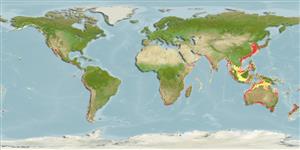Classificação / Names
Common names from other countries
Referência principal
Tamanho / Peso / Idade
Max length : 39.5 cm SL macho/indeterminado; (Ref. 9291); common length : 20.0 cm SL macho/indeterminado; (Ref. 188); Peso máx. publicado: 486.00 g (Ref. 6885); Idade máx. registada: 25 anos (Ref. 188)
Length at first maturity
Lm 9.0 range ? - ? cm
Ambiente
; marinhas; oceanódromo (Ref. 51243); intervalo de profundidade 0 - 200 m (Ref. 188)
Clima / Intervalo
Subtropical; 9°C - 21°C (Ref. 6390), preferred 23°C (Ref. 107945); 61°N - 47°S, 145°W - 180°E (Ref. 36641)
Distribuição
Indo-Pacific: southern Africa to the eastern Pacific (Ref. 27267). Three lineages were confirmed through cluster and parsimony analyses of haplotypic divergences: southern Africa (ocellatus) and Australia (neopilchardus); Chile (sagax) and California (caeruleus); and, Japan (melanostictus) (Ref. 36641).
Países | Áreas FAO | Ecossistemas | Ocorrências | Introduções
Descrição breve
Espinhos dorsais (total): 0; Raios dorsais moles (total): 13-21; Espinhos anais 0; Raios anais moles: 12 - 23; Vértebras: 48 - 54. Body cylindrical and elongate; ventral part of operculum with clear cut bony striae radiating downwards; belly rounded with ventral scutes; back blue green; flanks white, with 1 to 3 series of dark spots along the middle (Ref. 55763). The radiating bony striae on the operculum distinguish this species from all other clupeids in the area. The radiating bony striae on the operculum distinguish this fish from all other clupeids in the area. In New Zealand the species appears to grow larger (21.3 cm standard length; cf. 19.7 cm), has slightly larger eggs and a higher mean number of vertebrae (50.52; cf. 49 to 50.08 in various samples) (Ref. 859).
Categoria na Lista Vermelha da IUCN (Ref. 115185)
Ameaça para o homem
Harmless
Utilização humana
Pescarias: altamente comercial; isco: usually
Ferramentas
Relatórios especiais
Descarregue XML
Fontes da internet
Estimates of some properties based on models
Phylogenetic diversity index
PD50 = 1.0000 many relatives (e.g. carps) 0.5 - 2.0 few relatives (e.g. lungfishes)
Nível Trófico
2.8 ±0.1 se; Based on diet studies.
Resiliência
Médio, tempo mínimo de duplicação da população 1,4 - 4,4 anos (K=0.45; tm=2; tmax=13-25; Fec=10,000)
Vulnerabilidade
Low to moderate vulnerability (34 of 100)
Categoria de preço
